Andrew NG機器學習邏輯迴歸程式設計作業
Exercise 2:Logistic Regression—實現一個邏輯迴歸
問題描述:用邏輯迴歸根據學生的考試成績來判斷該學生是否可以入學。
這裡的訓練資料(training instance)是學生的兩次考試成績,以及TA是否能夠入學的決定(y=0表示成績不合格,不予錄取;y=1表示錄取)
因此,需要根據trainging set 訓練出一個classification model。然後,拿著這個classification model 來評估新學生能否入學。
訓練資料的成績樣例如下:第一列表示第一次考試成績,第二列表示第二次考試成績,第三列表示入學結果(0–不能入學,1–可以入學)
34.62365962451697, 78.0246928153624, 0
30.28671076822607, 43.89499752400101, 0
35.84740876993872, 72.90219802708364, 0
60.18259938620976, 86.30855209546826, 1
... ...訓練資料圖形表示 如下:橫座標是第一次考試的成績,縱座標是第二次考試的成績,右上角的 + 表示允許入學,圓圈表示不允許入學。(分數決定命運,太悲慘了!)

該訓練資料的圖形 可以通過Matlab plotData函式畫出來,它呼叫Matlab中的plot函式和find函式,Matlab程式碼實現如下:
0. Visualizing the data
Matlab將文字檔案中的訓練資料載入到 矩陣X 和 向量 y 中
%Initialization
clear all; close all; clc
data = csvread('ex2data1.txt');
X = data(:, [1, 2]); y = data(:, 3);
%X讀取的是第一列和第二列的所有資料
%y讀取的是第三列的所有資料錄取的點用+表示,未錄取的點用圓圈o表示。plotData函式的框架如下:
% ==================== Part 1: Plotting ====================
fprintf(['Plotting data with + indicating (y = 1) examples and o ' 載入完資料之後,執行以下程式碼(呼叫自定義的plotData函式),將圖形畫出來:
function plotData(X, y)
figure; hold on;
% ====================== YOUR CODE HERE ======================
pos = find(y == 1);
neg = find(y == 0);
plot(X(pos,1),X(pos,2),'k+','Linewidth',2,'MarkerSize',7);
plot(X(neg,1),X(neg,2),'ko','MarkerFaceColor','y','MarkerSize',7);註釋:
1.pos = find(y == 1)
找到y等於1的,資料的行數
neg = find(y == 0);
找到y等於0的,資料的行數
X(pos,1)表示X中,第pos行,第一列資料
X(pos,2)表示X中,第pos行,第二列資料
下面類似,不在贅述
2.plot(X(pos,1),X(pos,2),’k+’,’Linewidth’,2,’MarkerSize’,7);
表示。畫出,橫座標等於X(pos,1)縱座標等於X(pos,2)的點。用+號表示,線寬為2,大小為7
下面類似
圖形畫出來之後,對訓練資料就有了一個大體的視覺化的認識了。接下來就要實現 模型了,這裡需要訓練一個邏輯迴歸模型。
1. sigmoid function
要求實現如下函式,實現時z是向量,要對每個元素都做計算。
function g = sigmoid(z)
g = zeros(size(z));設定初值
g = 1 ./ (1 + exp(-z));
%‘點除’ 表示 1 除以矩陣(向量)中的每一個元素
end- Cost function and gradient
先來看一下計算前的準備工作
%% ============ Part 2: Compute Cost and Gradient ============
[m, n] = size(X);
X = [ones(m, 1) X];%向量化的常規套路,增加一行X0
initial_theta = zeros(n + 1, 1);%重置初值
[cost, grad] = costFunction(initial_theta, X, y);X是個矩陣,它每列表示一個特徵,每行表示一個例項。theta是n+1個元素的列向量。y是m個元素的結果向量。

代價函式公式

可以先用一個變數hx求出h(x),利用1中的函式
hx = sigmoid(X * theta);求和號中每一項對應一行,可以使用向量化的方法計算,最後用sum求和。
J = (-1/m) * sum(y .* log(hx) + (1-y) .* log(1 - hx));
梯度的計算公式
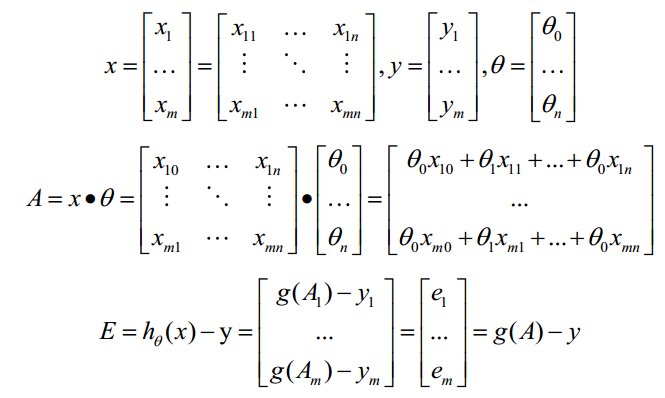

代價函式costFunction()的定義如下
function [J, grad] = costFunction(theta, X, y)
m = length(y); % number of training examples
grad = zeros(size(theta));
hx = sigmoid(X * theta);
J = (-1/m) * sum(y .* log(hx) + (1-y) .* log(1 - hx));
n = length(theta);
for j = 1 : n
grad(j) = sum((hx - y) .* X(:, j)) / m;
% X 為 training set 中的 feature variables, y 為training instance(訓練樣本的結果)結果,相當於對j
end
end通過呼叫costfunction.m檔案中定義的coustFunction函式,從而執行梯度下降演算法找到使代價函式J(theta)最小化的 邏輯迴歸模型引數theta。呼叫costFunction函式的程式碼如下:
3. fminunc
% Set options for fminunc
options = optimset('GradObj', 'on', 'MaxIter', 400);
% Run fminunc to obtain the optimal theta
% This function will return theta and the cost
[theta, cost] = ...
fminunc(@(t)(costFunction(t, X, y)), initial_theta, options);
% Plot Boundary
plotDecisionBoundary(theta, X, y);註釋:
1.fminunc中的@(t)(costFunction(t, X, y))是為了把函式costFunction轉換為只接受一個引數t的函式。
2.從上面程式碼的最後一行可以看出,我們是通過 fminunc 呼叫 costFunction函式,來求得 theta的,而不是自己使用 Gradient descent 在for 迴圈求導來計算 theta。for迴圈中求導計算theta,
既然已經通過Gradient descent演算法求得了theta,將theta代入到假設函式中,就得到了 logistic regression model.
呼叫plotDecisionBoundary函式畫出點和決策邊界,其中相關的程式碼如下(兩個引數的情況)
if size(X, 2) <= 3
% Only need 2 points to define a line, so choose two endpoints
plot_x = [min(X(:,2))-2, max(X(:,2))+2];
% Calculate the decision boundary line
plot_y = (-1./theta(3)).*(theta(2).*plot_x + theta(1));
% Plot, and adjust axes for better viewing
plot(plot_x, plot_y)
% Legend, specific for the exercise
legend('Admitted', 'Not admitted', 'Decision Boundary')
axis([30, 100, 30, 100])??????????以上邊界函式程式碼看不懂,先放棄,以後再看,先往下進行。
ex2的第104行是不需要的,因為在上面函式裡已經添加了圖示。在執行legend(‘Admitted’, ‘Not admitted’)反而會覆蓋掉分界線的圖示。
將theta代入到假設函式中,就得到了 logistic regression model,用圖形表示如下:
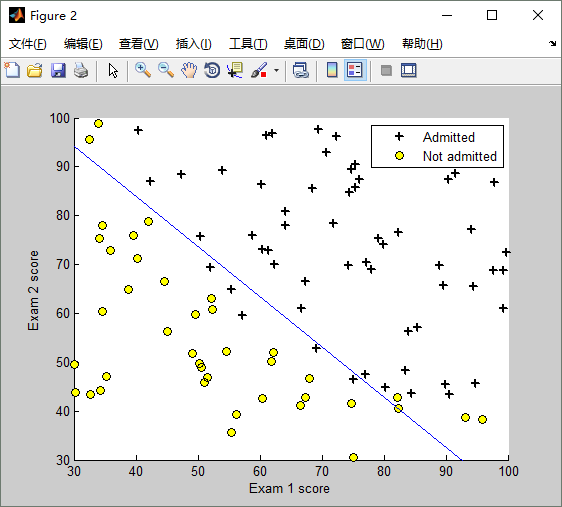
4. predict 模型的評估(Evaluating logistic regression)
那如何估計,求得的邏輯迴歸模型是好還是壞呢?預測效果怎麼樣?因此,就需要拿一組資料測試一下,測試程式碼如下:
%% ============== Part 4: Predict and Accuracies ==============
prob = sigmoid([1 45 85] * theta); %這是一組測試資料,第一次考試成績為45,第二次成績為85
fprintf(['For a student with scores 45 and 85, we predict an admission ' ...
'probability of %f\n\n'], prob);
% Compute accuracy on our training set
p = predict(theta, X);% 呼叫predict函式測試模型
fprintf('Train Accuracy: %f\n', mean(double(p == y)) * 100);
fprintf('\nProgram paused. Press enter to continue.\n');
pause;模型的測試結果如下:
For a student with scores 45 and 85, we predict an admission probability of 0.774323
Train Accuracy: 89.000000那predict函式是如何實現的呢?predict.m 如下:
function p = predict(theta, X)
m = size(X, 1); % Number of training examples
p = zeros(m, 1);
% ====================== YOUR CODE HERE ======================
% Instructions: Complete the following code to make predictions using
% your learned logistic regression parameters.
% You should set p to a vector of 0's and 1's
%
p = X*theta >= 0;
% =========================================================
end備註:double(y)表示將引數y轉為雙精度浮搜尋點型別.mean(A)表示求A的平均值
非常簡單,只有一行程式碼:p = X * theta >= 0,原理如下:
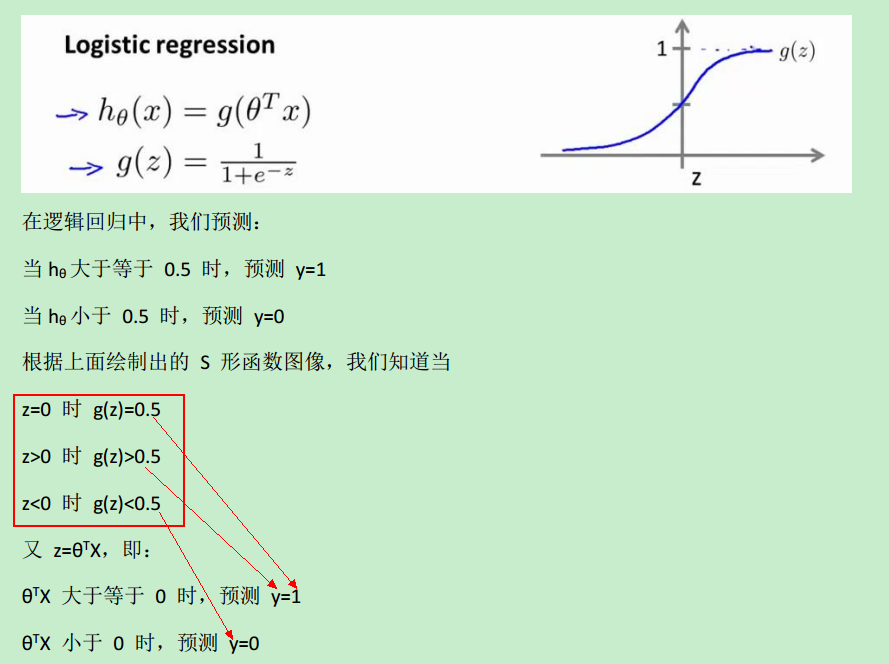
當h(x)>=0.5時,預測y==1,而h(x)>=0.5 等價於 z>=0
Regularization
為什麼需要正則化?正則化就是為了解決過擬合問題(overfitting problem)。那什麼又是過擬合問題呢?
一般而言,當模型的特徵(feature variables)非常多,而訓練的樣本數目(training set)又比較少的時候,訓練得到的假設函式(hypothesis function)能夠非常好地匹配training set中的資料,此時的代價函式幾乎為0。下圖中最右邊的那個模型 就是一個過擬合的模型。

**所謂過擬合,從圖形上看就是:假設函式曲線完美地通過中樣本中的每一個點。也許有人會說:這不正是最完美的模型嗎?它完美地匹配了traing set中的每一個樣本呀!
過擬合模型不好的原因是:儘管它能完美匹配traing set中的每一個樣本,但它不能很好地對未知的 (新樣本例項)input instance 進行預測呀!通俗地講,就是過擬合模型的預測能力差。
因此,正則化(regularization)就出馬了。
前面提到,正是因為 feature variable非常多,導致 hypothesis function 的冪次很高,hypothesis function變得很複雜(彎彎曲曲的),從而通過穿過每一個樣本點(完美匹配每個樣本)。如果新增一個”正則化項”,減少 高冪次的特徵變數的影響,那 hypothesis function不就變得平滑了嗎?
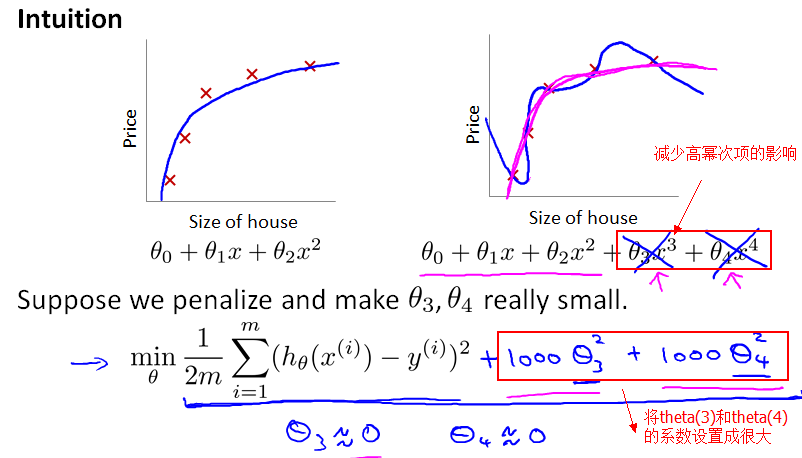
正如前面提到,梯度下降演算法的目標是最小化cost function,而現在把 theta(3) 和 theta(4)的係數設定為1000,設得很大,求偏導數時,相應地得到的theta(3) 和 theta(4) 就都約等於0了。
更一般地,我們對每一個theta(j),j>=1,進行正則化,就得到了一個如下的代價函式:其中的 lambda(λ)就稱為正則化引數(regularization parameter)
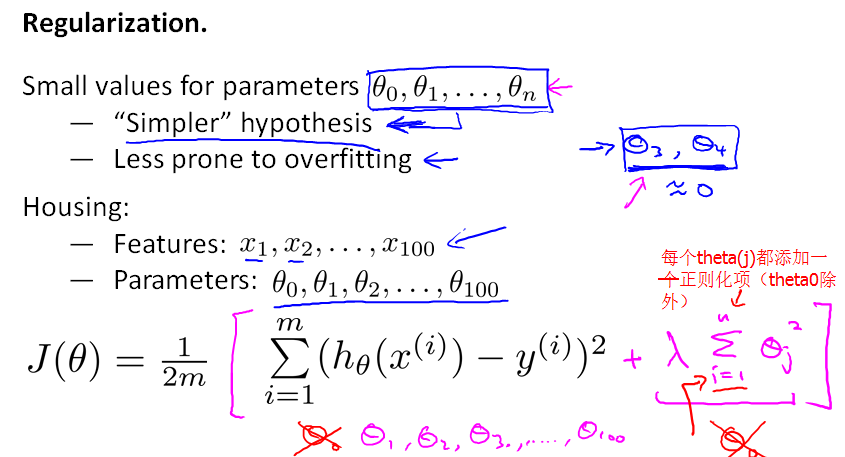
從上面的J(theta)可以看出:如果lambda(λ)=0,則表示沒有使用正則化;如果lambda(λ)過大,使得模型的各個引數都變得很小,導致h(x)=theta(0),從而造成欠擬合;如果lambda(λ)很小,則未充分起到正則化的效果。因此,lambda(λ)的值要合適。
最後,我們來看一個實際的過擬合的示例,原始的訓練資料如下圖:
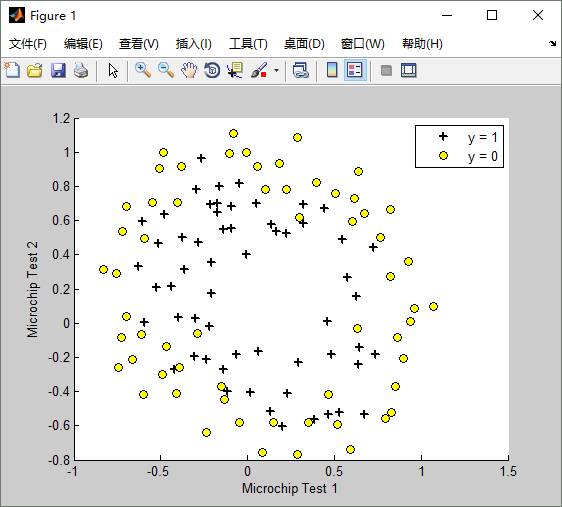
lambda(λ)==1時,訓練出來的模型(hypothesis function)如下:Train Accuracy: 83.050847
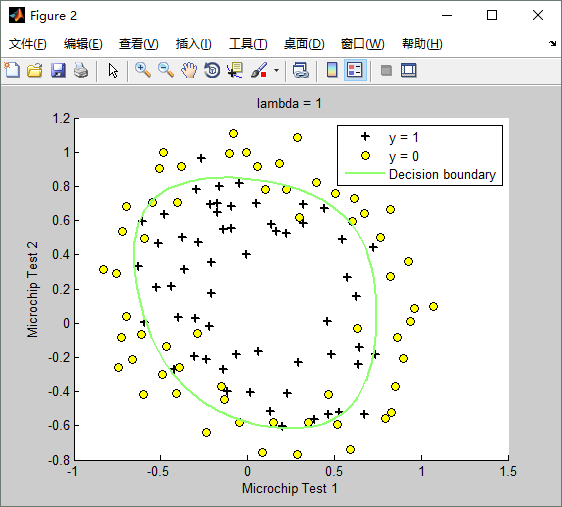
lambda(λ)==0時,不使用正則化,訓練出來的模型(hypothesis function)如下:Train Accuracy: 87.288136
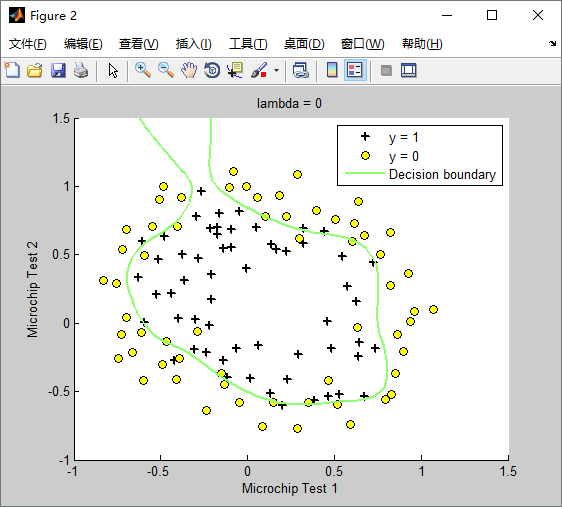
lambda(λ)==100時,訓練出來的模型(hypothesis function)如下:Train Accuracy: 61.016949
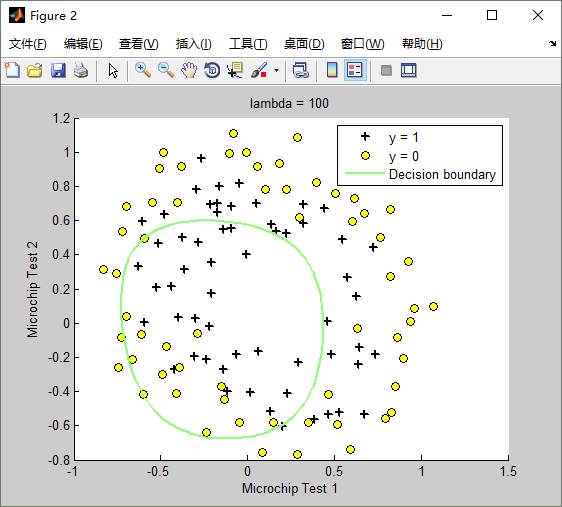
- Visualizing the data
這部分使用的程式碼和上面的相同

但這次的資料不能用直線來擬合出邊界。 - Feature mapping
使用已有的特徵的冪來當做新的特徵,這裡最高6次冪。程式碼如下
function out = mapFeature(X1, X2)
% MAPFEATURE Feature mapping function to polynomial features
%
% MAPFEATURE(X1, X2) maps the two input features
% to quadratic features used in the regularization exercise.
%
% Returns a new feature array with more features, comprising of
% X1, X2, X1.^2, X2.^2, X1*X2, X1*X2.^2, etc..
%
% Inputs X1, X2 must be the same size
%
degree = 6;
out = ones(size(X1(:,1)));
for i = 1:degree
for j = 0:i
out(:, end+1) = (X1.^(i-j)).*(X2.^j);
end
end
end??????????看不懂
- Cost function and gradient
公式如下
theta_0和之前的相同,其餘的引數在最後加了
程式碼如下
hx = sigmoid(X * theta);
J = (-1/m) * sum(y .* log(hx) + (1-y) .* log(1 - hx)) + ...
(lambda/(2*m)) * (sum(theta .* theta) - theta(1)^2);要注意減掉theta(1)的平方,因為公式中不包含 (theta_0),所以需要去掉。
??????????看不懂
梯度下降的演算法公式

計算程式碼
function [J, grad] = costFunctionReg(theta, X, y, lambda)
m = length(y); % number of training examples
grad = zeros(size(theta));
hx = sigmoid(X * theta);
J = (-1/m) * sum(y .* log(hx) + (1-y) .* log(1 - hx)) + ...
(lambda/(2*m)) * (sum(theta .* theta) - theta(1)^2);
grad(1) = (1/m) * sum((hx - y) .* X(:, 1));
n = length(theta);
for j = 2 : n
grad(j) = (1/m) * sum((hx - y) .* X(:, j)) + (lambda / m) * theta(j);
end
end- plotDecisionBoundary
畫出非線性邊界的程式碼
else
% Here is the grid range
u = linspace(-1, 1.5, 50);
v = linspace(-1, 1.5, 50);
z = zeros(length(u), length(v));
% Evaluate z = theta*x over the grid
for i = 1:length(u)
for j = 1:length(v)
z(i,j) = mapFeature(u(i), v(j))*theta;
end
end
z = z'; % important to transpose z before calling contour
% Plot z = 0
% Notice you need to specify the range [0, 0]
contour(u, v, z, [0, 0], 'LineWidth', 2)
end**
?????????????看不懂
**
5. change regularization parameters
修改ex2_reg.m第90行可以修改lambda的大小,等於0對應不進行正則化。

作業的關鍵程式碼
plotData
pos = find(y==1);
neg = find(y==0);
plot(X(pos,1),X(pos,2),'k+','Linewidth',2,'MarkerSize',7);
plot(X(neg,1),X(neg,2),'ko','MarkerFaceColor','y','MarkerSize',7);sigmoid
g=1./(1+exp(-z));costFunction
z=X*theta;
h=sigmoid(z);
J=sum(-y.*log(h)-(1-y).*log(1-h))/m;
grad=(1/m)*(X.'*(h-y));predict
h = sigmoid(X * theta);
p = (h >= 0.5); costFunctionReg
h=sigmoid(X*theta);
J=sum(-y.*log(h)-(1-y).*log(1-h))/m + (lambda/(2*m))*sum(theta(2:end).^2);
grad(1)=(1/m)*(X(:,1).'*(h-y));
grad(2:end) =(1/m)*(X(:,2:end).'*(h-y))+lambda*theta(2:end)/m;


